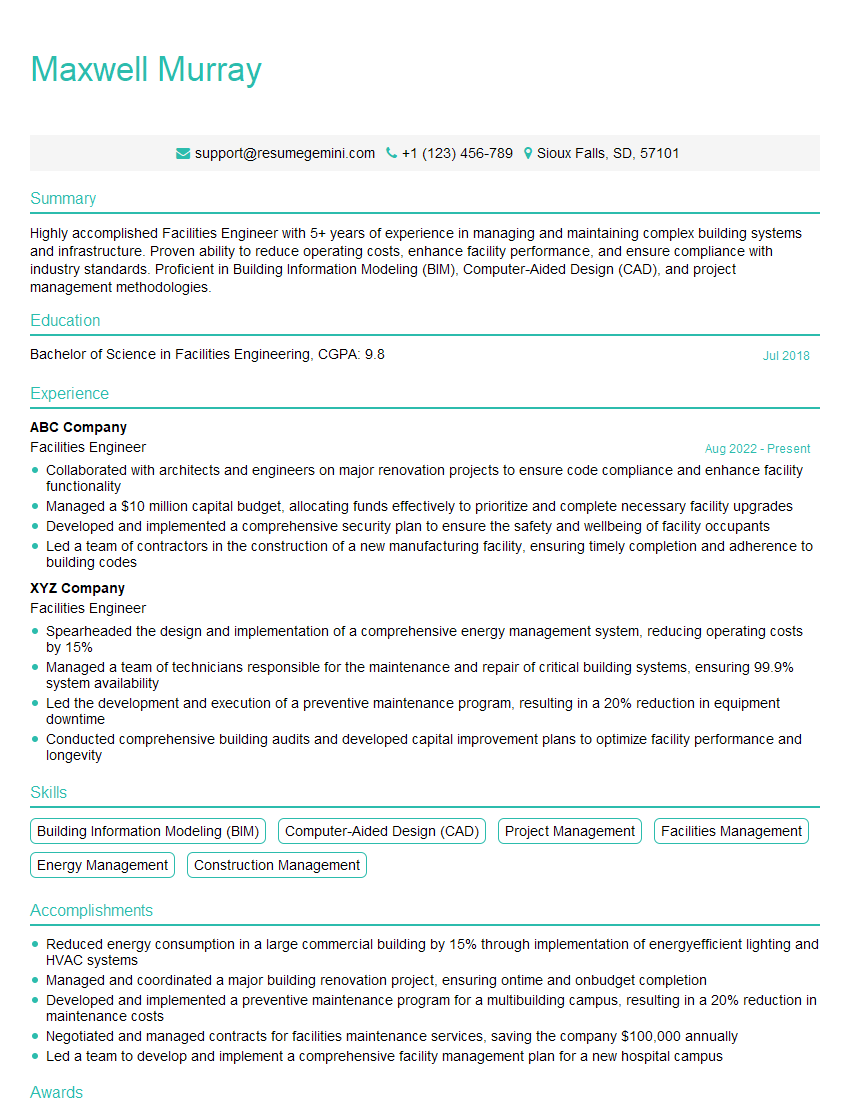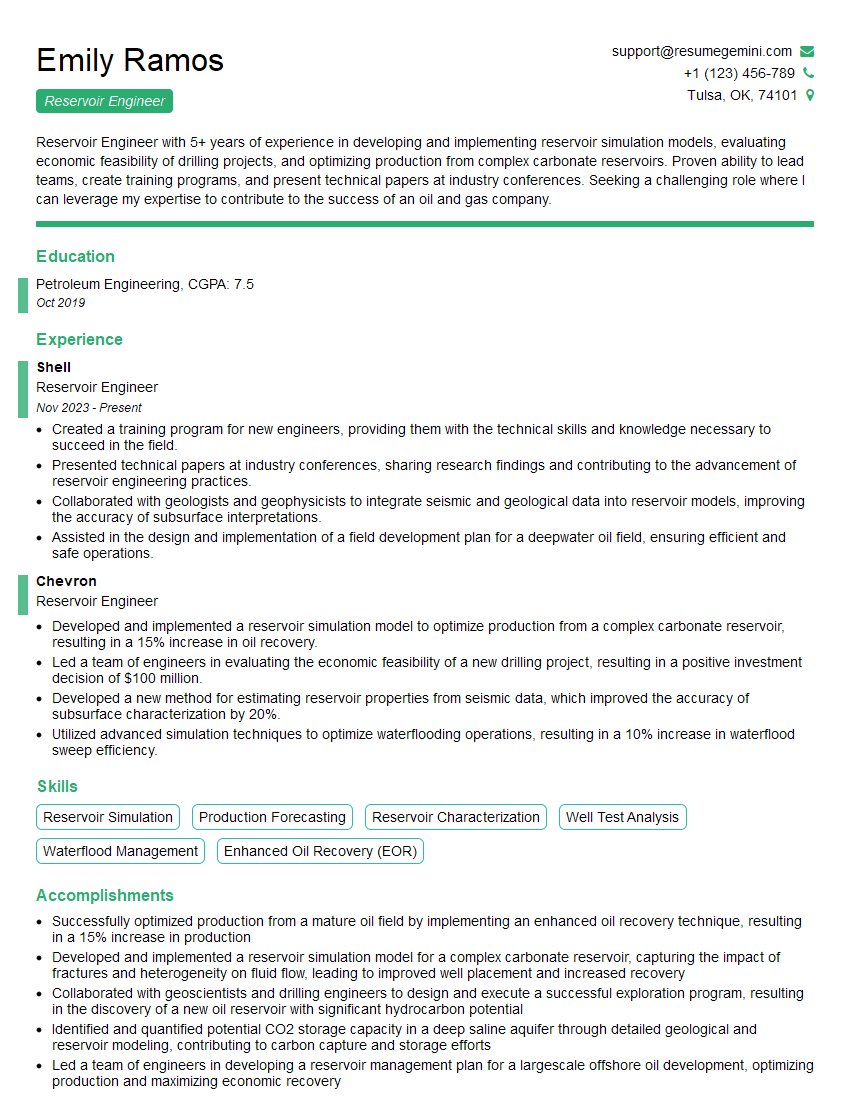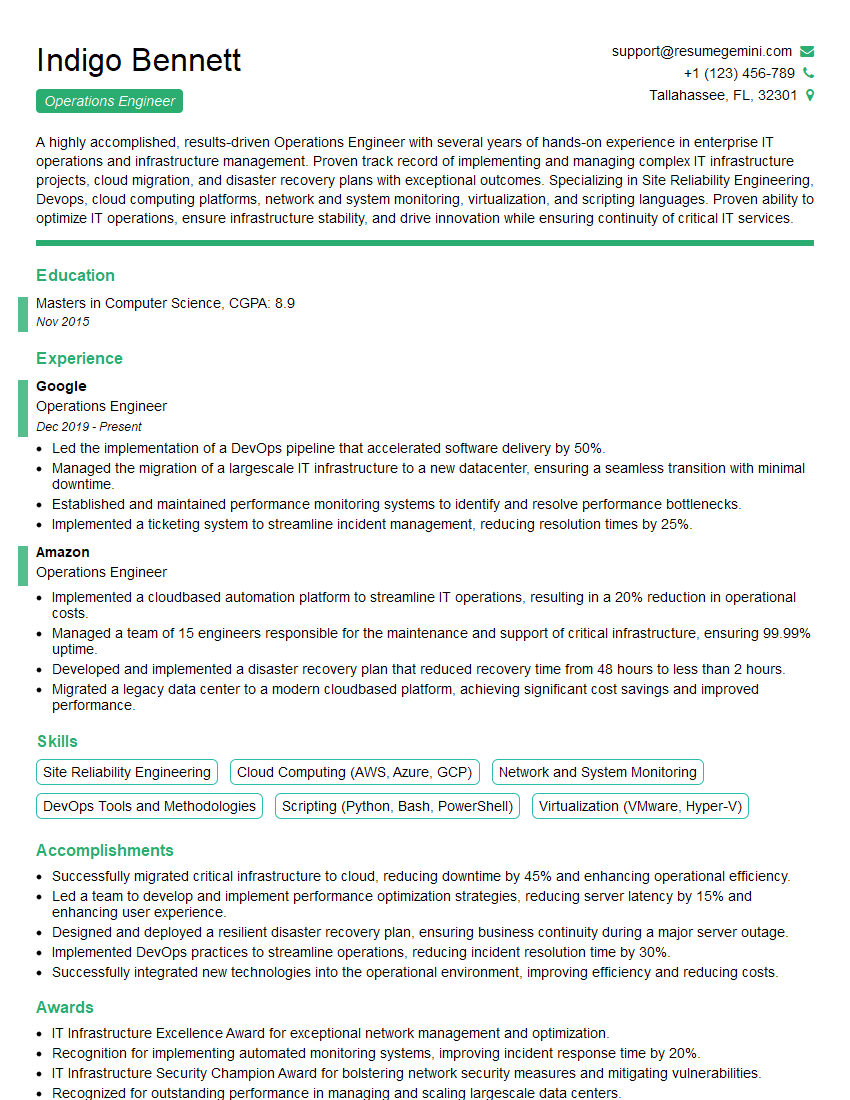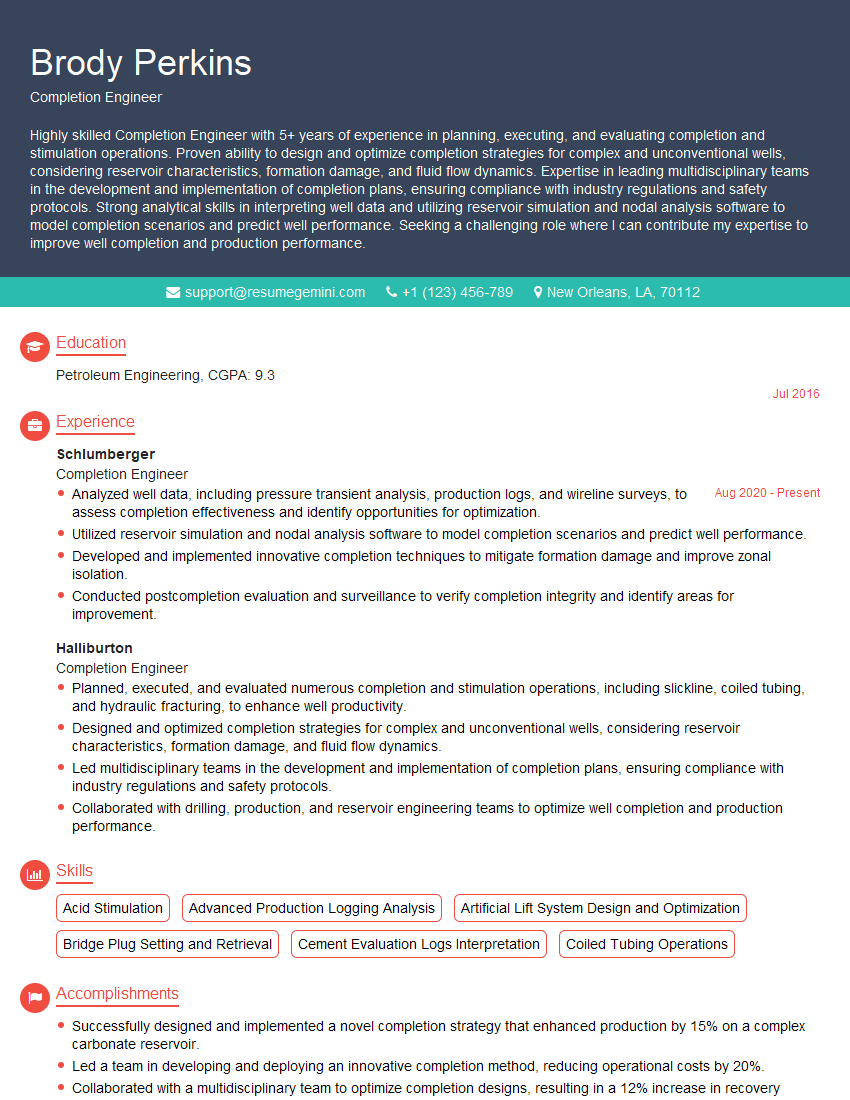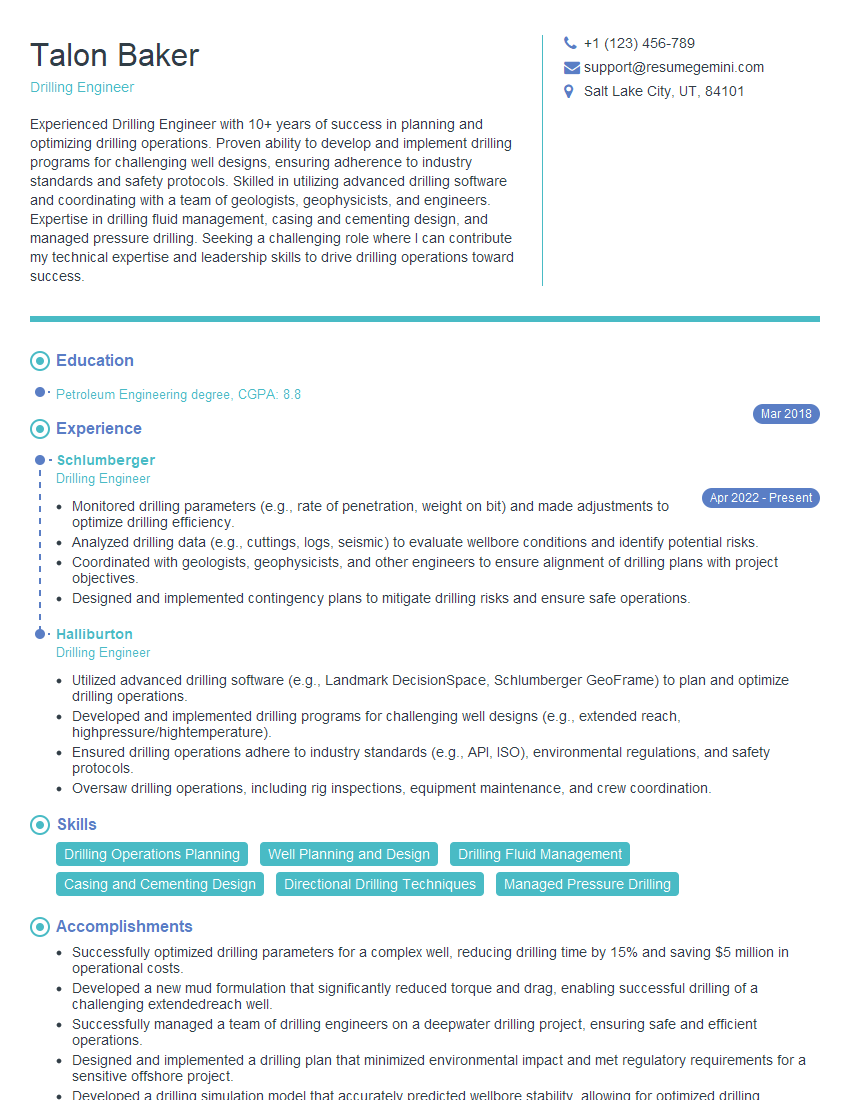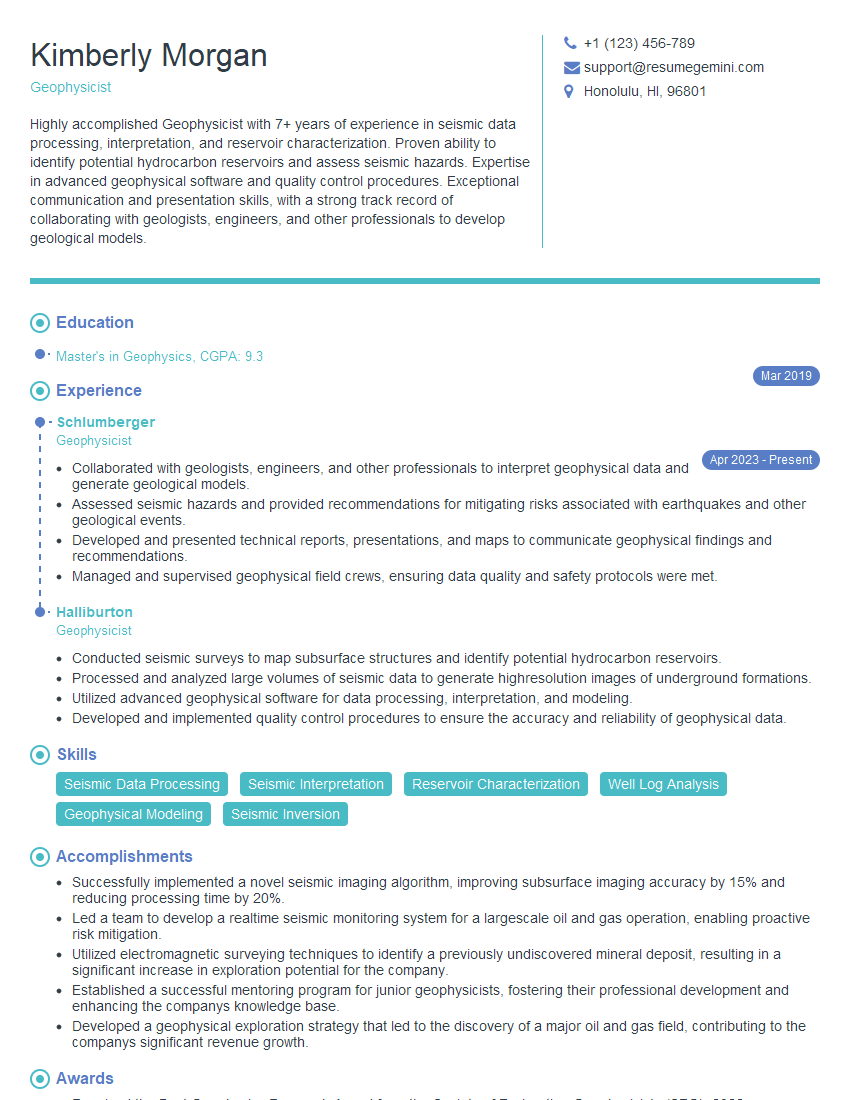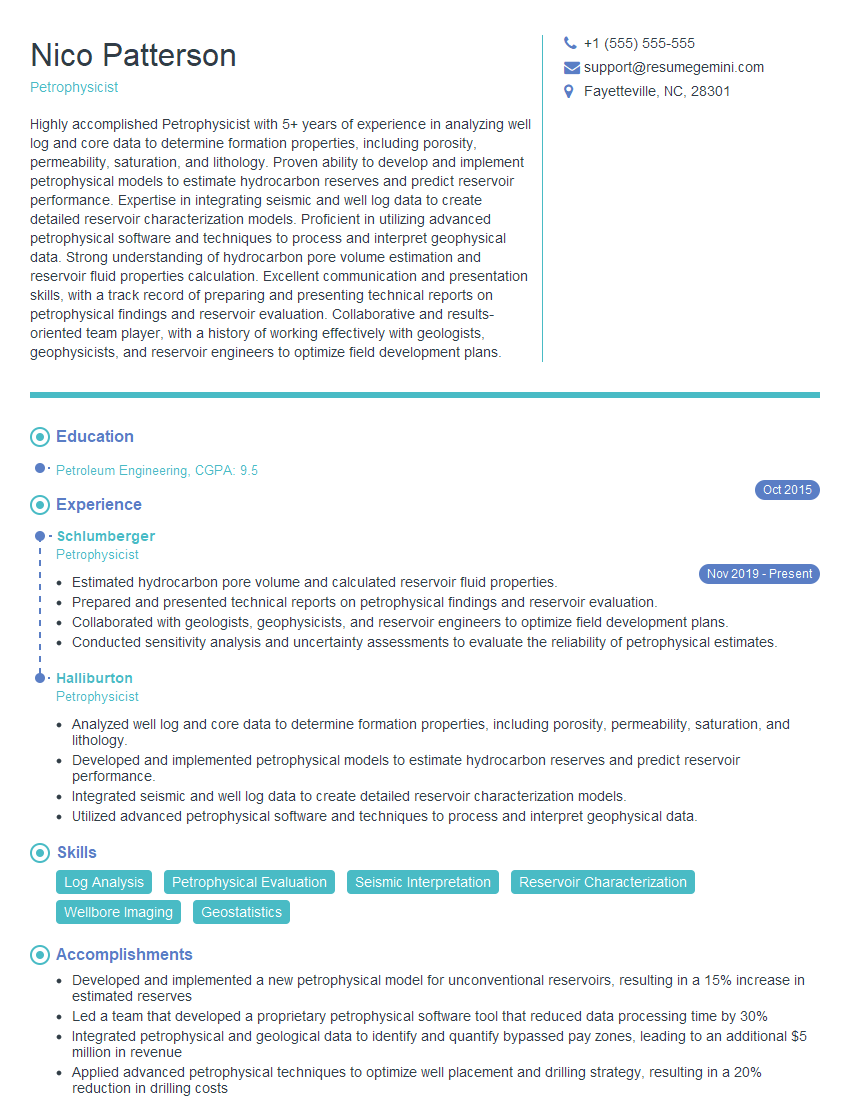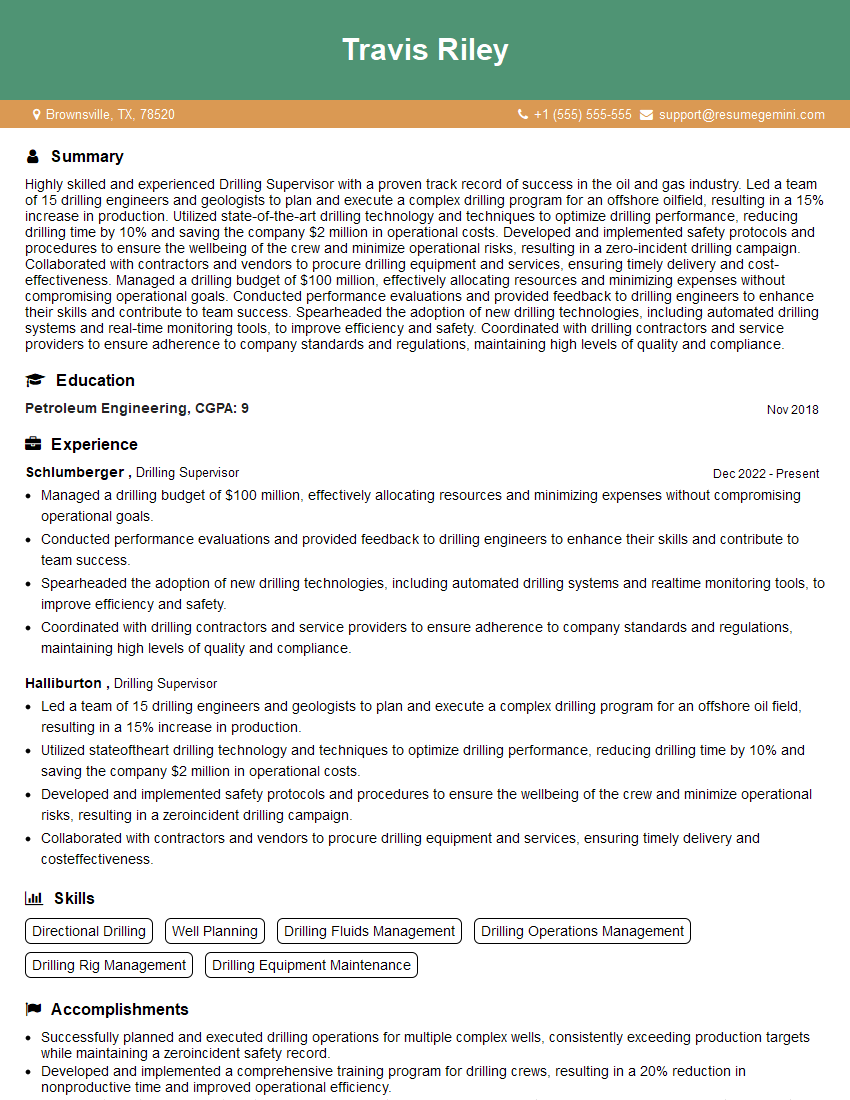Preparation is the key to success in any interview. In this post, we’ll explore crucial Gas and Oil Extraction Techniques interview questions and equip you with strategies to craft impactful answers. Whether you’re a beginner or a pro, these tips will elevate your preparation.
Questions Asked in Gas and Oil Extraction Techniques Interview
Q 1. Explain the different types of drilling rigs used in oil and gas extraction.
Drilling rigs are the heart of oil and gas extraction, each designed for specific applications based on well depth, location, and reservoir conditions. We broadly categorize them as land rigs and offshore rigs.
- Land Rigs: These are used on land and come in various sizes and configurations, from smaller, mobile rigs for shallow wells to massive jack-up rigs for deeper wells. Examples include:
- Top-drive rigs: These use a top-drive system to rotate the drill string, offering better control and automation.
- Walking rigs: These are equipped with tracks or legs, allowing them to move across land without needing to be disassembled.
- Offshore Rigs: These are designed for operations in oceans or seas and are far more complex. Different types include:
- Jack-up rigs: These raise themselves above the water’s surface on legs, providing a stable platform in shallow waters.
- Semi-submersible rigs: These float on pontoons and are stabilized by submerged columns, allowing operation in deeper waters.
- Drillships: These are essentially floating vessels that use dynamic positioning (GPS-based) to maintain their location, capable of operating in very deep waters.
The choice of rig depends on various factors, including water depth, environmental conditions, the planned well trajectory, and the overall budget. For instance, a shallow onshore well might only require a simple land rig, whereas a deepwater exploration well necessitates the use of a drillship.
Q 2. Describe the process of hydraulic fracturing (fracking).
Hydraulic fracturing, or fracking, is a technique used to enhance the permeability of shale and other tight rock formations to extract oil and gas. Think of it like creating tiny cracks in a rock to allow the hydrocarbons to flow more easily.
The process typically involves these steps:
- Well Drilling: A well is drilled vertically to the target formation, often thousands of feet below the surface.
- Casing and Cementing: Steel casing is inserted into the wellbore and cemented to provide stability and prevent contamination.
- Perforating: Once the target formation is reached, small holes are created in the casing to allow access to the shale.
- Fracturing Fluid Injection: A high-pressure mixture of water, sand (proppant), and chemicals is pumped into the well. This high pressure creates fractures in the shale.
- Proppant Placement: The sand particles (proppant) keep the fractures open, allowing the hydrocarbons to flow into the wellbore.
- Production: After fracturing, the well is put into production, with oil and gas flowing from the reservoir into the well.
Environmental concerns regarding fracking include water usage, potential groundwater contamination, and induced seismicity (earthquakes). These concerns necessitate rigorous environmental monitoring and best practices in fracking operations.
Q 3. What are the key parameters monitored during a well test?
Well testing is crucial for determining the reservoir’s properties and predicting its future production. Several key parameters are monitored during a well test:
- Pressure: Both bottomhole pressure (BHP) and surface pressure are meticulously recorded to understand the reservoir’s pressure dynamics and flow capacity. A sudden pressure drop might indicate a reservoir boundary.
- Flow Rate: This measures the volume of hydrocarbons produced over time, which is essential for assessing productivity.
- Temperature: Temperature changes can provide insights into fluid movement and reservoir heterogeneity.
- Fluid Composition: Analyzing the produced fluids (oil, gas, water) provides information about the reservoir’s composition and potential impurities.
- Gas-Oil Ratio (GOR): The ratio of gas to oil produced is a vital indicator of reservoir health and potential decline.
These parameters are used to create pressure-volume-temperature (PVT) diagrams, which are crucial for reservoir modeling and production forecasting. Analyzing the data obtained during well tests allows engineers to optimize production strategies and make informed decisions about further development.
Q 4. How do you determine the optimal well spacing in a reservoir?
Determining optimal well spacing is a complex task that involves balancing the cost of drilling additional wells against the potential increase in production. Several factors influence this decision:
- Reservoir Properties: Permeability, porosity, and reservoir pressure significantly affect well productivity and the extent of reservoir drainage. A highly permeable reservoir may allow for wider well spacing.
- Well Productivity: The ability of a single well to drain the surrounding reservoir dictates the needed spacing. Low-productivity wells necessitate closer spacing.
- Economic Factors: Drilling costs, operating expenses, and the price of oil and gas greatly affect the economic viability of different spacing strategies.
- Reservoir Simulation: Numerical reservoir simulation models are indispensable tools for predicting the performance of different well spacing scenarios, helping to optimize production and maximize profitability.
Often, a combination of analytical techniques, empirical correlations, and reservoir simulation is used to arrive at the optimal well spacing. For example, a high-permeability reservoir might allow for wider spacing, while a low-permeability reservoir would require closer spacing to achieve economic production.
Q 5. Explain the concept of reservoir simulation and its applications.
Reservoir simulation is a powerful tool used to predict the behavior of oil and gas reservoirs under different operating conditions. It involves creating a mathematical model of the reservoir, incorporating geological data, fluid properties, and production strategies.
Applications of reservoir simulation include:
- Production Forecasting: Predicting future oil and gas production rates, allowing for better planning and investment decisions.
- Reservoir Management Optimization: Identifying the optimal strategies for enhanced oil recovery (EOR) techniques, such as waterflooding or chemical injection.
- Well Placement Optimization: Determining the best locations for new wells to maximize production and minimize water production.
- Risk Assessment: Evaluating the uncertainties associated with reservoir development and mitigating potential risks.
Sophisticated software packages employ numerical methods to solve complex equations that describe fluid flow, heat transfer, and chemical reactions within the reservoir. The results provide valuable insights for engineers to make informed decisions, leading to improved production efficiency and profitability. For example, a simulation might reveal that a specific EOR technique is more effective in a particular part of the reservoir.
Q 6. What are the different types of artificial lift methods used in oil production?
Artificial lift methods are employed when the natural reservoir pressure is insufficient to bring oil to the surface at an economically viable rate. Several methods exist:
- Rod Pumping: A subsurface pump is driven by a surface-mounted pumping unit. It’s a widely used, reliable, and relatively inexpensive method for moderate well depths.
- Submersible Pumps (ESP): Electrically powered pumps submerged in the wellbore, suitable for higher flow rates and deeper wells. They offer higher efficiency compared to rod pumping.
- Gas Lift: Injected gas reduces the fluid column density, helping to lift the oil to the surface. It’s effective in high-volume wells.
- Progressive Cavity Pumps (PCP): These pumps use a helical rotor within a stator to create a continuous, progressive displacement of fluids. They’re used for viscous fluids.
- Hydraulic Lift: Uses a high-pressure fluid to lift oil to the surface. It is often used for short periods to temporarily boost production.
The selection of a specific artificial lift method depends on numerous factors, including well depth, reservoir pressure, fluid properties (viscosity, gas content), production rate targets, and cost considerations. For example, ESP is often favored for high-volume, deep wells due to its high efficiency, but rod pumping is preferred for simpler, less deep wells.
Q 7. Describe the different types of oil and gas reservoirs.
Oil and gas reservoirs are classified based on several geological factors, primarily their structure and the type of rock containing the hydrocarbons. Key types include:
- Structural Traps: These reservoirs are formed by geological structures, such as folds (anticlines) and faults, trapping the hydrocarbons.
- Stratigraphic Traps: These traps rely on variations in rock layers, like permeability changes, to trap hydrocarbons. Unconformities – points where rock layers are missing – can also form such traps.
- Combination Traps: These reservoirs have characteristics of both structural and stratigraphic traps.
- Conventional Reservoirs: These reservoirs are characterized by high porosity and permeability, allowing for relatively easy extraction of hydrocarbons.
- Unconventional Reservoirs: These reservoirs, such as shale oil and gas, have low permeability and require enhanced recovery techniques, like fracking, to extract hydrocarbons economically.
Each reservoir type has unique characteristics that affect extraction techniques and production rates. Understanding the reservoir type is essential for choosing appropriate drilling, completion, and production strategies. For instance, producing from a shale reservoir necessitates fracking, whereas conventional reservoirs often only require standard production methods.
Q 8. How do you evaluate the productivity index of a well?
The Productivity Index (PI) of a well is a crucial measure of its ability to produce hydrocarbons. It essentially tells us how much oil or gas a well can produce per unit of pressure drawdown. A higher PI indicates a more productive well. We evaluate it using the following formula:
PI = Q / (Pwf - Pe)
Where:
Qis the flow rate (e.g., barrels of oil per day or cubic meters of gas per day).Pwfis the bottomhole flowing pressure – the pressure at the bottom of the wellbore while it’s producing.Peis the average reservoir pressure – the pressure in the reservoir itself.
To determine the PI, we conduct a well test. This involves gradually increasing or decreasing the flow rate and carefully measuring the corresponding bottomhole pressure. Plotting this data on a graph allows us to calculate the PI from the slope of the straight line portion of the graph. For example, if a well produces 1000 barrels of oil per day with a bottomhole flowing pressure of 1000 psi and an average reservoir pressure of 2000 psi, its PI would be 1 BPD/psi (1000 BPD / (2000 psi – 1000 psi)). Understanding the PI helps optimize production strategies, predict future production, and assess the overall health of the well.
Q 9. What are the common challenges associated with offshore drilling?
Offshore drilling presents unique and significant challenges compared to onshore operations. These challenges stem from the harsh and remote environment:
- Environmental Conditions: Severe weather, including storms, high waves, and strong currents, can severely disrupt operations and create safety hazards. This necessitates robust weather forecasting and emergency response plans.
- Logistical Complexity: Transporting personnel, equipment, and supplies to offshore platforms is expensive and time-consuming. Maintenance and repairs also require careful planning and execution.
- Safety Risks: The inherent dangers of working at sea, including potential for accidents, equipment failures, and fire, are amplified. Rigorous safety protocols and emergency preparedness are essential.
- Infrastructure Limitations: Constructing and maintaining offshore infrastructure, such as platforms and pipelines, is significantly more challenging and costly than onshore counterparts. This also brings unique environmental considerations.
- Remote Location: Emergency response times are often longer due to distance from support bases and medical facilities. This necessitates self-sufficiency and advanced contingency planning.
- Regulatory Compliance: Offshore drilling is subject to strict environmental regulations, demanding meticulous planning and environmental impact assessments.
For instance, the Deepwater Horizon oil spill highlighted the severe consequences of inadequate safety measures and regulatory oversight in offshore drilling. Successfully managing these challenges requires advanced technology, rigorous safety procedures, comprehensive risk assessments, and skilled personnel.
Q 10. Explain the concept of pressure transient analysis.
Pressure transient analysis (PTA) is a powerful technique used to analyze the pressure response of a reservoir to changes in production or injection rates. It helps determine reservoir properties like permeability, porosity, and skin factor. Think of it like taking the reservoir’s ‘pulse’ to understand its characteristics.
The process involves monitoring pressure changes in a well over time following a change in flow rate. This data is then analyzed using specialized software to create a pressure-time plot. The shape and characteristics of this plot reveal information about the reservoir. For example, early-time pressure changes reveal information about the near-wellbore region (skin effect), while later-time data reveals information about the larger reservoir.
Different types of well tests, such as drawdown tests (production rate changes), buildup tests (production shut-in), and interference tests (pressure response in neighboring wells), provide different perspectives on the reservoir. PTA is crucial for reservoir modeling, production forecasting, and reservoir management decisions.
Q 11. Describe the different types of well completion techniques.
Well completion techniques refer to the procedures used after drilling to prepare the well for production. The goal is to ensure efficient and safe hydrocarbon flow from the reservoir to the surface. Different techniques are employed depending on reservoir characteristics and the type of hydrocarbons being produced.
- Openhole Completion: The simplest method, where the wellbore is left open to the reservoir. Suitable only for formations with high natural strength and low risk of sand production. It’s cost-effective but less controlled.
- Cased and Perforated Completion: The well is encased with steel casing, then perforated with small holes to allow hydrocarbon flow into the wellbore. This provides better control and reservoir protection. It’s more commonly used.
- Gravel Pack Completion: A gravel pack is placed around the wellbore to prevent sand production, maintaining well productivity. It is used in formations prone to sand production.
- Sand Control Completion: These techniques include screen filters or other methods to keep formation sand out of the wellbore. Important in unconsolidated reservoirs.
- Multi-lateral Completion: Horizontal wells can be extended laterally creating multiple branches, increasing production from a single well. Used to improve drainage area and productivity.
Choosing the appropriate completion method is critical for maximizing production and well longevity. A poorly designed completion can lead to premature well failure or reduced productivity. This decision takes into consideration the geological formation, fluid properties, and production goals.
Q 12. What are the environmental concerns associated with oil and gas extraction?
Oil and gas extraction poses several significant environmental concerns:
- Greenhouse Gas Emissions: The combustion of fossil fuels contributes to climate change through the release of greenhouse gases like carbon dioxide (CO2) and methane (CH4). Methane leaks during extraction and transportation are particularly impactful.
- Air Pollution: Extraction processes can release harmful pollutants into the air, such as volatile organic compounds (VOCs), nitrogen oxides (NOx), and particulate matter (PM).
- Water Pollution: Drilling fluids, produced water (water extracted with hydrocarbons), and spills can contaminate surface water and groundwater sources. This pollution can harm aquatic ecosystems and drinking water supplies.
- Habitat Disruption: Drilling operations can disturb or destroy natural habitats, leading to loss of biodiversity and ecosystem damage. This is particularly concerning in sensitive environments like wetlands and forests.
- Waste Disposal: The industry generates large volumes of waste, including drilling muds, cuttings, and produced water, which need careful disposal to avoid environmental harm.
- Seismic Activity: In some cases, wastewater disposal from oil and gas operations can induce seismic activity in certain geological areas, leading to increased earthquake risks.
Mitigating these concerns requires implementing responsible extraction practices, investing in cleaner technologies, and adhering to strict environmental regulations. This includes improved waste management, leak detection and repair technologies, and exploring alternative energy sources.
Q 13. How do you manage risks associated with drilling operations?
Managing risks in drilling operations is paramount for safety, environmental protection, and economic viability. A multi-faceted approach is necessary:
- Hazard Identification and Risk Assessment: Thorough identification of potential hazards, including geological, mechanical, environmental, and human factors, is the first step. A quantitative risk assessment helps prioritize and mitigate these hazards.
- Well Control Procedures: Rigorous well control procedures, including the use of blowout preventers (BOPs) and emergency shutdown systems, are essential to prevent uncontrolled well blowouts.
- Emergency Response Planning: Comprehensive emergency response plans, including spill response strategies, evacuation procedures, and communication protocols, are vital for handling unexpected events.
- Personnel Training and Competency: Well-trained and competent personnel are critical for safe and efficient operations. Regular training and competency assessments are crucial.
- Equipment Maintenance and Inspection: Regular maintenance and inspection of all equipment, including drilling rigs and safety systems, helps prevent equipment failures and accidents.
- Regulatory Compliance: Adherence to all relevant safety regulations and environmental guidelines is non-negotiable. This ensures compliance and minimizes legal and environmental risks.
- Data Monitoring and Analysis: Real-time monitoring of critical parameters, such as pressure, temperature, and flow rates, allows for early detection of potential problems.
The Deepwater Horizon incident underscores the devastating consequences of inadequate risk management. Proactive risk management, a strong safety culture, and continuous improvement are essential to prevent such disasters.
Q 14. Explain the importance of proper well casing design.
Proper well casing design is critical for the safe and efficient operation of oil and gas wells. The casing is a steel pipe cemented into the wellbore, providing several crucial functions:
- Containment: It prevents the flow of formation fluids (oil, gas, water) into the wellbore and the environment.
- Structural Support: It provides structural integrity to the wellbore, preventing collapse in unstable formations.
- Isolation: It isolates different zones within the wellbore, preventing fluid communication between different formations.
- Protection: It protects the wellbore from corrosion and other damage.
The design of the casing string, which involves the selection of casing sizes, grades, and cementing techniques, depends on various factors including well depth, formation pressure, geological conditions, and the type of fluids produced. Improper casing design can lead to several problems including wellbore instability, casing failure, environmental contamination, and costly workovers or well abandonment. Careful planning and engineering are necessary to ensure a robust and reliable casing design that meets the specific requirements of the well and minimizes risks.
Q 15. What are the different methods used for enhanced oil recovery (EOR)?
Enhanced Oil Recovery (EOR) techniques are employed when primary and secondary recovery methods become insufficient to extract economically viable amounts of oil from a reservoir. These techniques aim to improve the mobility of oil within the reservoir, making it easier to flow towards production wells. There are three main categories:
- Thermal Methods: These techniques involve injecting heat into the reservoir to reduce oil viscosity and improve its flow. Examples include steam injection (Cyclic Steam Stimulation, Continuous Steam Injection), in-situ combustion, and hot water flooding. Imagine heating honey – it becomes much easier to pour! Similarly, heating the oil makes it less viscous and easier to extract.
- Chemical Methods: This involves injecting chemicals to alter the oil-water-rock interactions, enhancing oil mobility. Polymer flooding increases the viscosity of the injected water, sweeping more oil towards the production wells. Surfactant flooding reduces the interfacial tension between oil and water, allowing oil to displace more easily. Alkaline flooding alters the pH of the reservoir, improving oil recovery. Think of it like adding soap to greasy dishes – the soap helps remove the grease (oil) more effectively.
- Miscible Flooding: This involves injecting fluids that mix completely (become miscible) with the oil, reducing interfacial tension and improving sweep efficiency. Liquified Petroleum Gas (LPG) or carbon dioxide (CO2) are commonly used. Imagine mixing water and alcohol – they blend seamlessly, similarly, miscible fluids help the oil to mix and flow more readily to the well.
The choice of EOR method depends on reservoir characteristics, oil properties, and economic considerations. A thorough reservoir characterization is crucial for selecting the most suitable technique.
Career Expert Tips:
- Ace those interviews! Prepare effectively by reviewing the Top 50 Most Common Interview Questions on ResumeGemini.
- Navigate your job search with confidence! Explore a wide range of Career Tips on ResumeGemini. Learn about common challenges and recommendations to overcome them.
- Craft the perfect resume! Master the Art of Resume Writing with ResumeGemini’s guide. Showcase your unique qualifications and achievements effectively.
- Don’t miss out on holiday savings! Build your dream resume with ResumeGemini’s ATS optimized templates.
Q 16. Describe the process of pipeline transportation of oil and gas.
Pipeline transportation is the backbone of the oil and gas industry, enabling the efficient and safe movement of hydrocarbons over long distances. The process involves several key stages:
- Gathering Systems: Individual wells connect to gathering pipelines, which collect the produced fluids (oil and gas) from multiple wells and transport them to a central processing facility.
- Processing Facilities: These facilities separate the oil and gas, remove impurities (water, sediment, and other contaminants), and prepare them for transportation. For example, natural gas is treated to remove harmful components like hydrogen sulfide (H2S).
- Trunk Pipelines: These large-diameter pipelines transport the processed oil and gas over long distances to refineries, storage facilities, or export terminals. They are often buried underground for safety and protection.
- Pigging: Special devices called ‘pigs’ are regularly sent through the pipelines to clean the inner walls, removing accumulated deposits and improving pipeline efficiency. Imagine cleaning a long straw using a small brush – the pig performs a similar function.
- Monitoring and Control: Sophisticated systems monitor pipeline pressure, flow rate, and temperature remotely, allowing operators to detect leaks and maintain safe and efficient operation. These systems are critical for safety and prevent environmental damage.
Pipeline safety is paramount, with stringent regulations and maintenance procedures in place to prevent leaks and accidents. Regular inspections, advanced leak detection technologies, and emergency response plans are critical components.
Q 17. What are the different types of drilling fluids and their functions?
Drilling fluids, also known as muds, are essential for drilling oil and gas wells. They serve several crucial functions:
- Wellbore Stabilization: The mud exerts pressure on the wellbore walls, preventing formation collapse and maintaining well stability. This is particularly crucial when drilling through unstable formations.
- Lubrication and Cooling: The mud lubricates the drill bit, reducing friction and wear, and also cools the bit, extending its lifespan. Think of it as oil for a car engine – it keeps things running smoothly.
- Waste Removal: The mud carries cuttings (rock fragments) from the bottom of the well to the surface, keeping the wellbore clear for continued drilling.
- Pressure Control: The mud pressure prevents formation fluids (oil and gas) from entering the wellbore, preventing uncontrolled flow (blowouts) and ensuring well control.
Different types of drilling fluids are used, depending on the formation being drilled and the well conditions:
- Water-based muds: The most common type, economical and environmentally friendly.
- Oil-based muds: Used in challenging formations where water-based muds are not effective, offering better lubrication and shale inhibition. However, they are more expensive and have environmental concerns.
- Synthetic-based muds: Offer a balance between performance and environmental friendliness. They are less damaging to the environment compared to oil-based muds but are also more expensive than water-based muds.
The choice of drilling fluid significantly impacts drilling efficiency, wellbore stability, and environmental protection.
Q 18. How do you interpret well logs?
Well logs are recordings of physical properties of the formations penetrated by a wellbore. They provide crucial information about the subsurface geology, enabling reservoir characterization, hydrocarbon identification, and well completion planning. Interpretation involves analyzing these logs to understand the reservoir’s characteristics.
The process involves:
- Data Acquisition: Various logging tools are lowered into the wellbore to measure different parameters.
- Data Processing: The raw data is processed and corrected for various factors (e.g., borehole effects) to enhance accuracy.
- Log Analysis: Different logs are analyzed individually and in combination to interpret reservoir properties like porosity, permeability, water saturation, and lithology (rock type). For example, the gamma ray log indicates the shale content, while the neutron porosity log estimates the pore space in the rock.
- Correlation: Data from different wells is correlated to build a three-dimensional model of the reservoir.
- Reservoir Modeling: The interpreted data is incorporated into reservoir simulation models to predict reservoir performance and optimize production strategies.
Experienced petrophysicists use their expertise and software tools to integrate different logs and create a comprehensive picture of the reservoir, guiding decision-making throughout the life cycle of a well.
Q 19. Explain the concept of permeability and its importance in reservoir engineering.
Permeability is a measure of a rock’s ability to allow fluids (oil, gas, water) to flow through its pore spaces. It’s a critical parameter in reservoir engineering, as it dictates the rate at which hydrocarbons can be produced. Think of it as the ‘ease’ with which a fluid can move through the rock.
High permeability rocks allow fluids to flow easily, resulting in high production rates. Low permeability rocks hinder fluid flow, leading to lower production rates and potentially requiring enhanced oil recovery techniques. Permeability is expressed in units of Darcy or millidarcy.
The importance of permeability lies in:
- Production Forecasting: Permeability significantly impacts the rate at which hydrocarbons can be produced from a reservoir. Accurate permeability estimations are crucial for forecasting future production.
- Reservoir Simulation: Permeability is a key input parameter in reservoir simulation models, which are used to predict reservoir behavior under different production scenarios.
- Well Completion Design: Understanding permeability helps in designing effective well completions, such as hydraulic fracturing (fracking), which enhances permeability in tight reservoirs.
- EOR Method Selection: EOR techniques are often chosen based on the reservoir’s permeability. For example, water flooding is more effective in high-permeability reservoirs.
Determining permeability accurately is crucial for making informed decisions throughout the life cycle of an oil and gas reservoir.
Q 20. Describe the different types of geological formations found in oil and gas reservoirs.
Oil and gas reservoirs are formed in diverse geological formations, each with its unique characteristics affecting hydrocarbon accumulation and extraction. Some common types include:
- Sandstones: These porous and permeable sedimentary rocks are among the most prolific hydrocarbon reservoirs. The interconnected pore spaces within the sandstone allow oil and gas to accumulate and flow. Imagine a sponge – the pores are similar to the spaces in a sandstone reservoir holding the oil.
- Carbonates (Limestones and Dolomites): These rocks are formed from the remains of marine organisms. They can be highly porous and permeable, often forming excellent reservoirs, especially in fractured formations. These can be complex structures with high heterogeneity.
- Shales: These fine-grained sedimentary rocks have very low permeability, often acting as hydrocarbon source rocks. However, advancements in hydraulic fracturing technology have made it possible to extract hydrocarbons from shale formations (shale gas and shale oil).
- Fractured Reservoirs: Many reservoirs have naturally occurring fractures that enhance permeability, providing pathways for hydrocarbon flow. These fractures can be of various orientations and sizes, making the reservoir’s behavior complex.
- Unconventional Reservoirs: These include tight gas sands, coal bed methane, and shale gas, requiring specialized extraction techniques due to their low permeability.
Understanding the specific geological formation of a reservoir is critical for planning efficient exploration and production strategies.
Q 21. What are the safety precautions taken during drilling operations?
Safety is paramount during drilling operations. A multi-layered approach encompassing procedures, equipment, and training is essential to minimize risks.
- Well Control: This involves the use of blowout preventers (BOPs) – critical safety devices that prevent uncontrolled flow of formation fluids. Regular testing and maintenance are vital.
- Emergency Response Plans: Comprehensive plans are developed and regularly practiced to address potential emergencies, including well control issues, fires, and equipment failures. This includes designated personnel and specialized equipment.
- Personal Protective Equipment (PPE): All personnel must wear appropriate PPE, such as hard hats, safety glasses, gloves, and safety footwear, to minimize the risk of injury.
- Hazard Identification and Risk Assessment: Regular risk assessments are conducted to identify potential hazards and implement appropriate control measures. This is a proactive approach to prevent incidents.
- Training and Competency: Rigorous training programs are provided to ensure that all personnel are competent and aware of safety procedures. Regular refresher courses are also conducted to maintain expertise.
- Environmental Protection: Procedures are implemented to minimize environmental impact, including proper disposal of drilling waste and prevention of spills.
- Regular Inspections and Maintenance: Equipment inspections and maintenance are performed regularly to prevent malfunctions and ensure the safe operation of the drilling rig.
A strong safety culture, fostered through continuous improvement and commitment from all levels of the organization, is essential for ensuring safe and responsible drilling operations.
Q 22. How do you manage production optimization in a mature oil field?
Production optimization in a mature oil field focuses on maximizing remaining reserves and profitability from a well that has already seen significant production. This involves a multi-faceted approach that goes beyond simply increasing production rate. We need to carefully balance increasing production with maintaining reservoir pressure and integrity.
- Enhanced Oil Recovery (EOR): Techniques like waterflooding, polymer flooding, or gas injection are implemented to displace remaining oil and improve sweep efficiency. For example, waterflooding involves injecting water into the reservoir to push oil towards production wells. The choice of EOR method depends on reservoir characteristics.
- Well Intervention: This could include stimulation treatments like acidizing or fracturing to increase permeability around the wellbore, or workovers to repair or replace damaged equipment. Imagine it like unclogging a pipe to allow better flow.
- Production Monitoring and Data Analysis: Real-time monitoring of production parameters (pressure, flow rates, water cut) is crucial. Sophisticated software and data analytics help identify areas for improvement, predict future performance, and optimize production strategies. This data allows for proactive adjustments.
- Reservoir Simulation and Modeling: Sophisticated models help predict the response of the reservoir to various interventions, allowing for informed decision-making. We can virtually test different scenarios before implementing them in the field.
- Artificial Lift Optimization: Mature fields often require artificial lift techniques (e.g., ESPs, gas lift) to maintain production. Optimizing these systems is critical to minimize energy consumption and maximize production. This might involve adjusting settings to maintain optimal pressure and flow.
The key is integrating all these strategies to create a comprehensive, cost-effective plan that maximizes the remaining economic life of the field.
Q 23. Explain the role of petrophysics in reservoir characterization.
Petrophysics plays a vital role in reservoir characterization, bridging the gap between geological observations and reservoir engineering. It uses physical measurements and principles to determine the properties of subsurface rocks and the fluids they contain, which are critical for understanding reservoir behavior and optimizing production.
- Porosity: Petrophysics determines the percentage of pore space within the rock, which indicates the potential storage capacity for hydrocarbons. Think of it as the ‘space available’ for oil and gas.
- Permeability: This measures the ability of the rock to allow fluids to flow through it. High permeability is essential for efficient hydrocarbon production. It’s like how easily water flows through a pipe.
- Fluid Saturation: Petrophysics helps determine the proportion of oil, water, and gas present in the pore spaces. This is key to understanding the hydrocarbon reserves.
- Rock Mechanical Properties: Petrophysical analysis helps determine the rock’s strength and stress state, which is critical for wellbore stability and completion design. This helps us avoid wellbore collapses.
- Formation Evaluation: Data from well logs (e.g., gamma ray, resistivity, neutron porosity) is used to create detailed models of the reservoir’s properties. These logs are like ‘medical scans’ of the subsurface.
By integrating petrophysical data with geological information, we obtain a comprehensive understanding of reservoir architecture and fluid distribution, allowing for accurate reserves estimation and optimal well placement and production strategies.
Q 24. What are the different types of downhole tools used in oil and gas production?
Downhole tools are essential for monitoring, controlling, and enhancing oil and gas production. They are deployed within the wellbore to gather data, perform interventions, and manipulate the reservoir.
- Measurement While Drilling (MWD) Tools: These tools measure parameters like inclination, azimuth, and pressure during drilling, providing real-time information about well trajectory and formation properties.
- Logging While Drilling (LWD) Tools: These tools acquire data about formation properties while drilling, allowing for immediate evaluation and adjustments to the drilling plan.
- Production Logging Tools: These tools measure fluid flow rates, pressure profiles, and other parameters in producing wells to optimize production and identify potential issues. They’re like ‘check-up’ tools for the well.
- Perforating Guns: These tools create openings in the wellbore casing to allow hydrocarbons to flow into the well. It’s like making holes in a water pipe to allow water flow.
- Artificial Lift Equipment: Downhole pumps (e.g., electric submersible pumps (ESPs), progressive cavity pumps) or gas lift systems enhance production from low-pressure reservoirs.
- Intervention Tools: Tools used for well stimulation, such as hydraulic fracturing equipment and acidizing tools.
The specific tools used vary depending on the well’s characteristics, production stage, and the intervention required.
Q 25. Describe the process of well decommissioning.
Well decommissioning is the process of permanently shutting down and abandoning a well after it has reached the end of its productive life. It’s a crucial step in ensuring environmental protection and safety.
- Wellbore Isolation: This involves sealing off the wellbore to prevent the flow of fluids to the surface and to protect groundwater. Cement is commonly used to plug sections of the well.
- Surface Equipment Removal: Surface infrastructure such as derricks, pipelines, and storage tanks is removed and disposed of responsibly. This minimizes environmental impact.
- Site Restoration: The well site is reclaimed and restored to its pre-drilling condition, often involving soil remediation and landscaping.
- Regulatory Compliance: The entire decommissioning process must adhere to stringent government regulations and industry best practices to ensure environmental protection and public safety. The process is heavily documented.
- Plugging and Abandonment (P&A): This is the core part of the process. It involves placing multiple cement plugs along the wellbore to create an effective barrier to prevent fluid migration.
The specific decommissioning procedures vary depending on the well’s type, location, and regulatory requirements. It’s a complex and costly process, but essential for responsible resource management.
Q 26. How do you determine the economic viability of an oil and gas project?
Determining the economic viability of an oil and gas project involves a detailed financial analysis, considering various factors. It is not merely about the potential profits, but also about risk mitigation and long-term sustainability.
- Reserves Estimation: Accurately estimating the volume of recoverable hydrocarbons is critical for determining potential revenue.
- Capital Expenditure (CAPEX): This includes all costs associated with exploration, drilling, development, and infrastructure.
- Operating Expenditure (OPEX): These are the ongoing costs associated with production, maintenance, and transportation.
- Revenue Projection: Forecasting future oil and gas prices is a crucial element, typically involving scenario planning to account for price volatility.
- Discount Rate: The discount rate reflects the time value of money and risk involved in the project. Higher risk requires higher discount rates.
- Net Present Value (NPV): This metric discounts all future cash flows to their present value, providing a measure of the project’s overall profitability.
- Internal Rate of Return (IRR): The IRR is the discount rate at which the NPV of the project is zero. It represents the project’s return on investment.
- Payback Period: This is the time it takes for the project to recover its initial investment.
A project is considered economically viable if it has a positive NPV, an acceptable IRR, and a reasonable payback period, all within an acceptable risk profile. Sensitivity analysis is often used to assess the impact of various factors on these key metrics.
Q 27. What are the challenges of extracting unconventional oil and gas resources?
Extracting unconventional oil and gas resources, such as shale gas and tight oil, presents unique challenges compared to conventional resources. These resources are trapped in low-permeability formations, requiring advanced technologies to extract them economically.
- Low Permeability: The rock formations have very small pore spaces, making it difficult for hydrocarbons to flow to the wellbore. This necessitates stimulation techniques like hydraulic fracturing.
- Hydraulic Fracturing (Fracking): While effective, fracking has environmental concerns regarding water usage, wastewater disposal, and potential induced seismicity. Careful management is crucial.
- Horizontal Drilling: Horizontal drilling techniques are employed to intersect longer sections of the reservoir, increasing the contact area and production potential. This increases complexity and cost.
- Complex Geology: Unconventional reservoirs are often geologically complex, making reservoir characterization and production forecasting challenging. Data acquisition and interpretation are critical.
- Water Management: Large volumes of water are used in fracking, and managing the produced wastewater is a significant environmental and logistical challenge.
- Regulatory Hurdles: Strict environmental regulations surrounding unconventional resource extraction can lead to increased costs and delays.
Overcoming these challenges requires advanced technologies, rigorous environmental management, and a careful balance between economic benefits and environmental protection.
Q 28. Explain the impact of fluctuating oil prices on oil and gas operations.
Fluctuating oil prices significantly impact oil and gas operations, influencing investment decisions, production strategies, and profitability. It’s like a rollercoaster ride for the industry.
- Investment Decisions: High oil prices encourage exploration and development investments, while low prices can lead to project delays or cancellations. Companies need to carefully time their investments.
- Production Optimization: During periods of low prices, operators may focus on cost reduction and efficiency improvements, prioritizing the most profitable wells and deferring less profitable operations. This involves optimizing operational efficiency.
- Profitability: Profit margins are directly affected by oil price movements. Low prices can squeeze profit margins, impacting company revenues and shareholder returns. Hedging strategies can help mitigate some risks.
- Exploration and Development: High prices provide an incentive for exploring new resources and developing existing fields. Low prices often result in cutbacks in exploration activities.
- Layoffs and Workforce Reductions: During periods of prolonged low prices, companies may be forced to reduce their workforce to cut costs.
Companies must employ various strategies, including hedging, diversification, and operational efficiency improvements, to mitigate the impact of fluctuating oil prices and ensure long-term stability.
Key Topics to Learn for Gas and Oil Extraction Techniques Interview
- Reservoir Characterization: Understanding porosity, permeability, and fluid saturation; applying geological and geophysical data to predict reservoir performance.
- Drilling Techniques: Familiarization with various drilling methods (vertical, horizontal, directional); understanding mud systems and wellbore stability.
- Completion Techniques: Knowledge of well completion designs (perforating, fracturing, sand control); understanding the optimization of production.
- Production Techniques: Understanding artificial lift methods (pumping units, gas lift); managing production rates and pressures; troubleshooting production issues.
- Enhanced Oil Recovery (EOR) Techniques: Familiarity with various EOR methods (waterflooding, chemical injection, thermal recovery); understanding their applications and limitations.
- Health, Safety, and Environmental (HSE) Regulations: Knowledge of relevant HSE regulations and best practices in the oil and gas industry; demonstrating commitment to safety procedures.
- Production Optimization and Data Analysis: Analyzing production data to identify areas for improvement; utilizing software and tools for data interpretation and decision-making.
- Economic Evaluation of Projects: Understanding the economic aspects of oil and gas extraction projects; performing cost analysis and profitability assessments.
- Problem-Solving and Troubleshooting: Demonstrating ability to identify and solve problems related to drilling, completion, and production operations; applying critical thinking skills to complex scenarios.
Next Steps
Mastering Gas and Oil Extraction Techniques is crucial for a successful and rewarding career in this dynamic industry. A strong understanding of these concepts will significantly enhance your interview performance and open doors to exciting opportunities. To maximize your job prospects, creating a compelling and ATS-friendly resume is essential. We highly recommend using ResumeGemini to build a professional and impactful resume that showcases your skills and experience effectively. ResumeGemini offers examples of resumes tailored specifically to Gas and Oil Extraction Techniques to guide you through the process.
Explore more articles
Users Rating of Our Blogs
Share Your Experience
We value your feedback! Please rate our content and share your thoughts (optional).
What Readers Say About Our Blog
Hi, I’m Jay, we have a few potential clients that are interested in your services, thought you might be a good fit. I’d love to talk about the details, when do you have time to talk?
Best,
Jay
Founder | CEO

